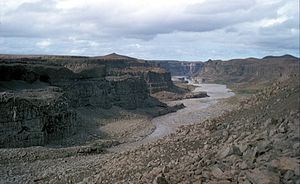geo.wikisort.org - River
Jökulsá á Fjöllum (Icelandic pronunciation: [ˈjœːkʏlsˌauː auː ˈfjœtlʏm]; "glacial river in the mountains") is the second longest river in Iceland (206 km). Its source is the Vatnajökull glacier. It flows into the Greenland Sea. Jökulsá á Fjöllum streams over the waterfalls Selfoss, Dettifoss, Hafragilsfoss, and Réttarfoss, the second of which is the most powerful waterfall in Europe.[1]
| Jökulsá á Fjöllum | |
|---|---|
 Jökulsá á Fjöllum downstream from Dettifoss | |
| Location | |
| Country | Iceland |
| Physical characteristics | |
| Source | Vatnajökull |
| • location | Central Iceland |
| Length | 206 km (128 mi)approx. |
| Basin size | 7,380 km2 (2,850 sq mi)approx. |
| Discharge | |
| • average | 183 m3/s (6,500 cu ft/s)approx. |
The source of the river is in the Vatnajökull National Park, one of three national parks in Iceland. The river is located in the northeast of Iceland and forms the eastern boundary of Ódáðahraun, an extensive lava field. Its drainage basin is the largest in Iceland at 7,380 square kilometers.

Glacial flooding
Dettifoss drops into the Jökulsárgljúfur canyon, a feature which, along with the Ásbyrgi gorge, appears to have been formed by catastrophic glacial flooding caused by volcanic activity. The volcano in question was possibly Bárðarbunga, which has been identified as posing the risk of a similar event in the future.[2]
The largest jökulhlaups (glacial floods) in Iceland are known to have occurred along Jökulsá á Fjöllum between 7100 and 2000 yr BP.[3] The source of these floods were likely eruptions of a major volcano under the Vatnajökull glacier, in the late Holocene. The peak discharge of this flood is estimated to have been 900,000 cubic metres per second (32,000,000 cu ft/s).[3] This can be compared to the flow of the Amazon river, which has an average discharge of 209,000 cubic metres per second (7,400,000 cu ft/s).
The latest research concludes that the Jökulsárgljúfur canyon was formed by three flooding events. These key events occurred two, five and nine thousand years ago, separated by millennia of relative stability.[1]
See also
References
- "Canyon carved by three short, savage floods". BBC News. February 2015. Retrieved 10 February 2015.
- Dettifoss waterfall could be completely reformed by glacial flooding from Bárðarbunga volcano
- Petteri Alho, Andrew J. Russell, Jonathan L. Carrivick, Jukka Käyhkö (2005). "Reconstruction of the largest Holocene jökulhlaup within Jökulsá á Fjöllum, NE Iceland". Quaternary Science Reviews. 24 (22): 2319–2334. Bibcode:2005QSRv...24.2319A. doi:10.1016/j.quascirev.2004.11.021.
{{cite journal}}: CS1 maint: uses authors parameter (link)
Further reading
- Vander-Molen, Paul (September 1984). "Iceland's Wild Glacier-born River". National Geographic. Vol. 166, no. 3. pp. 306–321. ISSN 0027-9358. OCLC 643483454.
На других языках
[de] Jökulsá á Fjöllum
Die Jökulsá á Fjöllum (dt. „Gletscherfluss auf den Bergen“[2], gemeint ist im Hochland) ist mit 206 km Länge der zweitlängste Fluss Islands[3] und entspringt am Brúarjökull, einem der Talgletscher des Eisschildes Vatnajökull. Sie strömt größtenteils durch das unbewohnte Hochland im Nordosten Islands und mündet unweit von Kópasker in den Öxarfjörður.- [en] Jökulsá á Fjöllum
[es] Jökulsá á Fjöllum
Jökulsá á Fjöllum es el segundo río más largo de Islandia,[1] tras el Thjórsá, con 206 kilómetros. Nace en el sistema glaciar del Vatnajökull, al norte de la isla. En su recorrido hay varias cascadas. Desemboca en el océano Atlántico.[it] Jökulsá á Fjöllum
Lo Jökulsá á Fjöllum è uno dei più lunghi fiumi islandesi. Come indica chiaramente il nome, Jökulsá, fiume di ghiacciaio, lo Jökulsá á Fjöllum è un fiume glaciale che nasce dalla parte settentrionale dell'immensa calotta del Vatnajökull e scorre per 206 km prima di incontrare, nell'estremo nord dell'Islanda, l'Oceano Artico. Raccoglie un bacino totale di 7.950 km², che è il più vasto dell'isola, di questi, 1.700 km² sono sub-glaciali.[ru] Йёкюльсау-ау-Фьёдлюм
Йёкюльсау-ау-Фьёдлюм[1] (исл. Jökulsá á Fjöllum) — вторая по длине река (после Тьоурсау) в Исландии. Длина реки — 206 км.[источник не указан 1725 дней]Другой контент может иметь иную лицензию. Перед использованием материалов сайта WikiSort.org внимательно изучите правила лицензирования конкретных элементов наполнения сайта.
WikiSort.org - проект по пересортировке и дополнению контента Википедии